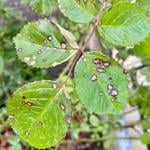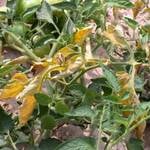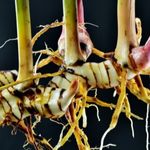
How to Grow Ginger Rhizomes
Grow Guide #2462
Family: Zingiberaceae
Binomial name: Zingiber officinale
Life Cycle: Perennial
This 'How to Grow' guide details everything a home gardener needs to know to plant, grow and care for Ginger (Zingiber officinale).
When to Plant Ginger
Ginger is a warm season crop. Use the table below to identify the best time of year to plant ginger rhizomes in your climate.
| JAN | FEB | MAR | APR | MAY | JUN | JUL | AUG | SEP | OCT | NOV | DEC | |
|---|---|---|---|---|---|---|---|---|---|---|---|---|
| Cool | ||||||||||||
| Temperate | ||||||||||||
| Sub-Tropical | ||||||||||||
| Tropical | ||||||||||||
| Arid |
Preparation
Ginger plants are best grown in full sun or part shade. Choose a location that will receive at least 3 hours of full sun each day. A position that receives morning sun and afternoon shade is ideal.
Ginger plants need a well drained soil enriched with plenty of organic matter. Prepare soil by weeding it thoroughly, digging it over to loosen it and adding aged animal manure or compost. Keep the area free of weeds until planting. Learn more about preparing soil for planting here.
Ginger plants can be grown in containers, and container growing is recommended for temperate and cold climates. Use a good quality potting mix and make sure your container is large enough for mature plants; a minimum of 40 litres is recommended for ginger. During the growing season, keep in mind that container grown plants may need additional fertiliser to encourage healthy growth.
How to Plant Ginger Rhizomes
Ginger plants grow from rhizomes, which are swollen pieces of stem that grow horizontally under the soil. Shoots emerge from growing points, often called 'eyes', on the rhizomes.
Ginger plants need soil temperatures of 20-30°C to produce shoots.
- Plant the rhizomes with the growing points facing up so the soil is just covering the rhizome.
- Space rhizomes 15cm apart.
- Keep the soil just moist but not wet until shoots emerge.
How to Grow Ginger
Ginger plants need regular watering during the growing season. Do not let soil dry out; keep soil evenly moist but not waterlogged. Water deeply in the early morning or late afternoon. Avoid watering the leaves of plants to avoid fungal diseases. Learn more about watering here. Reducing watering as the plant dies back will encourage rhizome growth.
If soil was well prepared no extra fertiliser should be necessary. In poor soil or to give your plants an extra boost, application of a balanced fertiliser or one formulated for fruit and vegetables can be beneficial:
- Apply slow release fertiliser at the recommended rate when shoots are 5-10cm tall.
- Apply liquid fertiliser at the recommended rate and frequency during spring and summer.
Ginger plants may die back in autumn or winter in cold climates. When the leaves start to yellow and die, harvest the crop or cut plants back just above ground level. Alternatively, move pots indoors or into a greenhouse over the cooler months. If rhizomes become crowded, lift them in spring, break them into smaller pieces and replant.
How to Harvest Ginger
Ginger should be ready to harvest in approximately 120-160 days.
Rhizomes are ready to harvest when they are large enough to eat, and can be harvested as needed, or all at once at the end of the season. Harvest individual rhizomes by gently digging to unearth them from the soil. Shake off any excess soil and cut the stems 1-2cm above the top of the rhizome. To harvest whole plants, wait until the foliage begins to yellow and die back, then lift the entire plant from the ground. Remove excess soil and trim stems as described above.
Ginger can be stored short term at room temperature or in an air-tight container in the fridge. Store ginger unpeeled. For longer term storage, ginger can be peeled and frozen, pickled, candied or dried.
Common Problems when Growing Ginger
Like all plants, ginger is susceptible to some pests, diseases and other problems. Below is a list of the most common problems gardeners encounter when growing ginger plants:
 Bacterial leaf spot is a disease that causes irregularly shaped brown spots on all above-ground parts of a plant. The spots at first appear to be wet but become dry and scab-like over time. Leaves and flowers can fall prematurely. Water plants at soil level (not on the leaves), dispose of fallen leaves and fruit and practice crop rotation.
Bacterial leaf spot is a disease that causes irregularly shaped brown spots on all above-ground parts of a plant. The spots at first appear to be wet but become dry and scab-like over time. Leaves and flowers can fall prematurely. Water plants at soil level (not on the leaves), dispose of fallen leaves and fruit and practice crop rotation. Fusarium wilt and verticillium wilt are diseases caused by soil-borne fungi. The fungi enter a plants’ roots and prevent water and nutrients from moving through plants. Leaves and branches will wilt, dry off and die and leaves may yellow. There is no cure for wilt but choosing resistant varieties, disposing of affected plants and soil, practicing good garden hygiene and crop rotation will all help to prevent it spreading.
Fusarium wilt and verticillium wilt are diseases caused by soil-borne fungi. The fungi enter a plants’ roots and prevent water and nutrients from moving through plants. Leaves and branches will wilt, dry off and die and leaves may yellow. There is no cure for wilt but choosing resistant varieties, disposing of affected plants and soil, practicing good garden hygiene and crop rotation will all help to prevent it spreading. Rotten rhizomes are caused by pathogens entering bulbs after sitting in cold, wet soil, being temporarily waterlogged or being exposed to warm temperatures in winter. Rhizomes may show obvious signs of rot, have no roots or shoots, or produce stunted yellow leaves but no flowers. Plant rhizomes in free-draining soil, raised garden beds or containers at the recommended depth; do not overwater rhizomes before shoots emerge.
Rotten rhizomes are caused by pathogens entering bulbs after sitting in cold, wet soil, being temporarily waterlogged or being exposed to warm temperatures in winter. Rhizomes may show obvious signs of rot, have no roots or shoots, or produce stunted yellow leaves but no flowers. Plant rhizomes in free-draining soil, raised garden beds or containers at the recommended depth; do not overwater rhizomes before shoots emerge.


.png)



